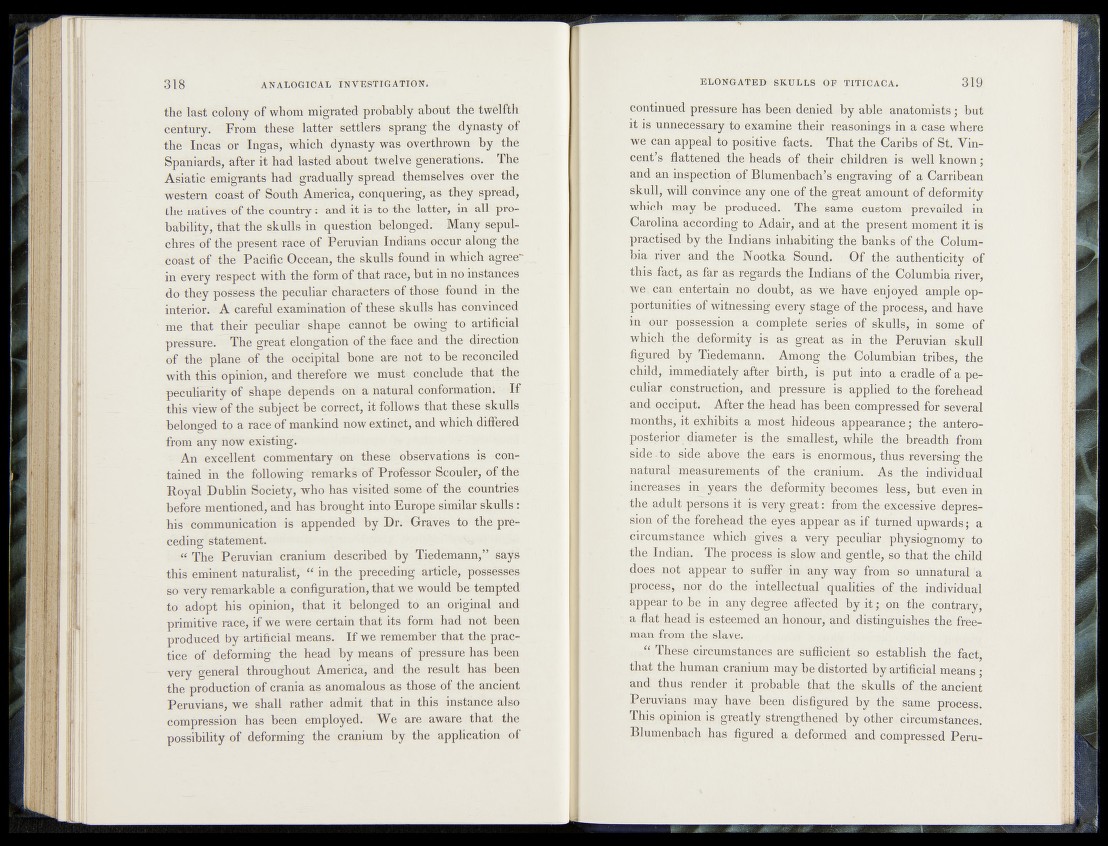
the last colony of whom migrated probably about the twelfth
century. From these latter settlers sprang the dynasty of
the Incas or Ingas, which dynasty was overthrown by the
Spaniards, after it had lasted about twelve generations. The
Asiatic emigrants had gradually: spread themselves over the
western coast of South America, conquering, as they spread,
the natives of the country: and it is to the latter, in-all probability,
that the skulls in question belonged. Many sepulchres
of the present race of Peruvian Indians occur along the
coast of the Pacific Occean, the skulls found in which agree*"
in every respect with the form of that race, but in no instances
do they possess the peculiar characters of those found*in the
interior. A careful examination of these skulls has convinced
ine that their peculiar-shape cannot be owing to artificial
pressure. The great elongation of the face and the direction
of the plane of the occipital bone are not to be reconciled
with this opinion, and therefore we mustv conclude that;.the
peculiarity of shape depends on a natural conformation:'• If
this view of the subject "be correct, it follows that these skulls
belonged to a race of mankind now extinct, and which-differed
from any now existing.
An excellent commentary on these observations is -contained
in the following remarks of Professor Scoulefyofeithd
Royal Dublin Society, who has visited some of the countries
before mentioned, and has brought into Europe similar Skulls:
his communication is appended by Dr. Graves to the preceding
statement.
“ The Peruvian cranium described by Tiedemann,” says
this eminent naturalist, “ in the preceding article, possesses
so very remarkable a configuration, that we would be tempted
to adopt his opinion, that it belonged to an original and
primitive race, if we were certain that its form had not been
produced by artificial means. If we remember that the practice
of deforming the head by means of pressure has been
very general throughout America, and the result. has been
the production of crania as anomalous as those of the ancient
Peruvians, we shall rather admit that in this instance also
compression has been employed. We are aware that the
possibility of deforming tlm cranium by the application of
continued pressure has been denied by able anatomists; but
it is unnecessary/to examine their reasonings in a ease where
we can appeal to; positive facts.. That the Caribs of St. Vincent’s
flattened the heads of their childrën is well known;
and an inspection of Blumenbach’s engraving of a Carribean
skull, will convince any one of the great amount of deformity
which may be produced. The same custom prevailed in
Carolina.according to Adair, and at-the present moment it is
practised by the Indians inhabiting ftlje banks of the Columbia:
river and the Nootka . Sound. Of the authenticity of
this fact, as far as regards the Indians of thé Columbia river,
we,can entertain no doubt, as We have enjoyed:ample opportunities
of'witnessing every stage.of the process, and have
in •‘.■our* possession, a complètebseries of -skulls, in some of
which' the deformity is. as great as. in .the Peruvian skull
figured by Tiedemann. Among the. ^Columbian tribes,/ the
child, immediacy after birth, is put into a cradle of a peculiar..
construction, and pressure is applied to the forehead
and;peoiput. After the head has. been compressed for several
moiiths, it exhibits a mpstphideous .appearance; the antero-
pdstgrior „diameter is the smallest, while the breadth from
si.de;» to- side $ above- the ears is .enormous,, thus reversing.* the
natural""measurement&i^J^th©; cranium. As the individual
increases in / years the deformity “becomes less, but even in
the adult persons it is very great: from the excessive depres-
sion pf,-thۤforehead the eyes appear as if turned upwards; a
circumstance which -gives a very. peculiar, -physiognomy to
tbe; Indian. The, prqee„esjs slow and gentle,iso that the child
does .not appear to,puffer in any way from-so unnatural a
process, nor do the intellectual qualities of the individual
appear to be in any degji§&^ected by i t ; .on the conia?a^
a flat head is esteemed an honour, and distinguishes the frfee-r
man from the slave..
“ These circumstances arp,sufficient so establish the fact,
that the human cranium maybe distorted b y artificial means;
and thus render it probable that the skulls of the ancient
Peruviaiis may have been disfigured by the same process.
This opinion is, .greatly strengthened,by other: cireutastances.
Blumenbach has figured a deformed and compressed Peru